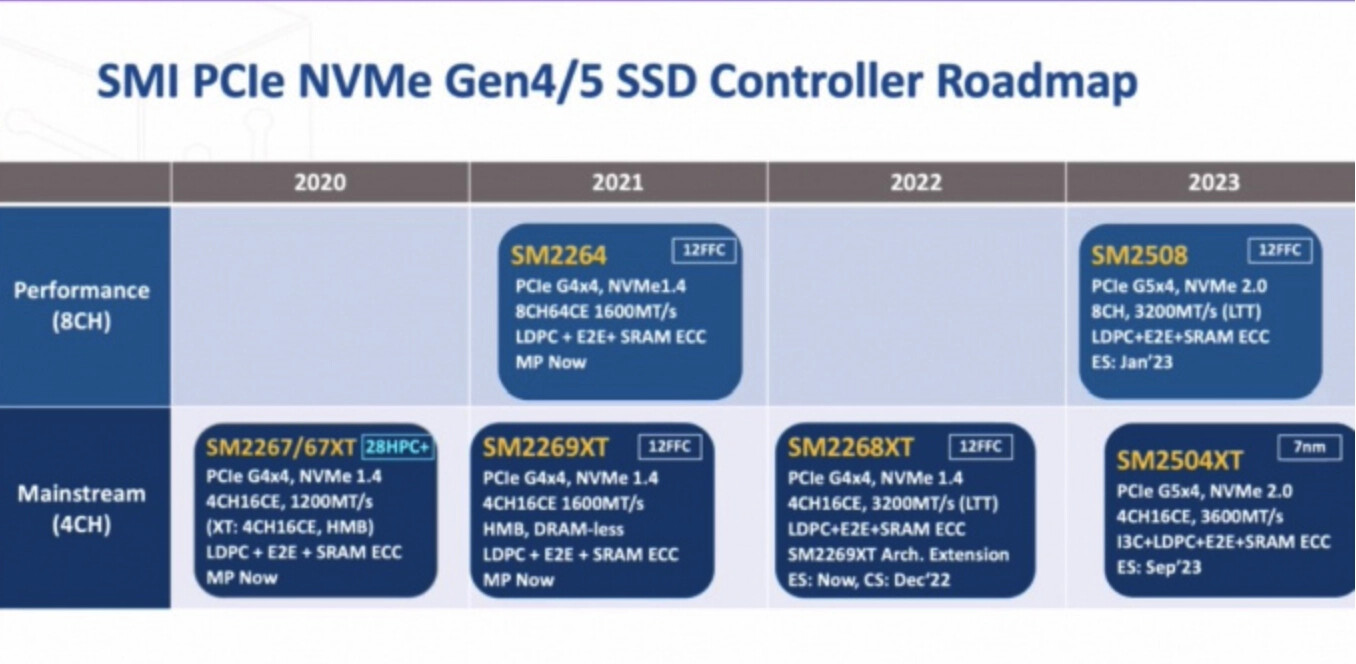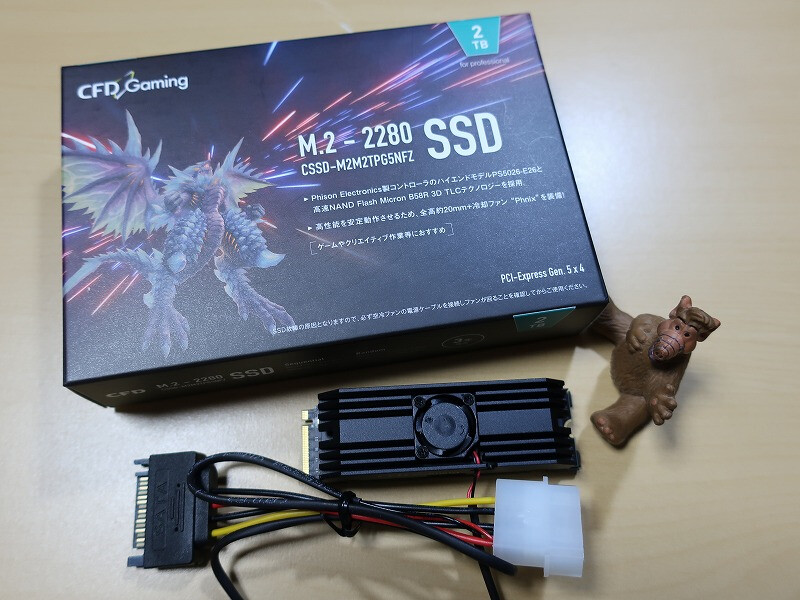TheLostSwede
News Editor
- Joined
- Nov 11, 2004
- Messages
- 16,189 (2.27/day)
- Location
- Sweden
| System Name | Overlord Mk MLI |
|---|---|
| Processor | AMD Ryzen 7 7800X3D |
| Motherboard | Gigabyte X670E Aorus Master |
| Cooling | Noctua NH-D15 SE with offsets |
| Memory | 32GB Team T-Create Expert DDR5 6000 MHz @ CL30-34-34-68 |
| Video Card(s) | Gainward GeForce RTX 4080 Phantom GS |
| Storage | 1TB Solidigm P44 Pro, 2 TB Corsair MP600 Pro, 2TB Kingston KC3000 |
| Display(s) | Acer XV272K LVbmiipruzx 4K@160Hz |
| Case | Fractal Design Torrent Compact |
| Audio Device(s) | Corsair Virtuoso SE |
| Power Supply | be quiet! Pure Power 12 M 850 W |
| Mouse | Logitech G502 Lightspeed |
| Keyboard | Corsair K70 Max |
| Software | Windows 10 Pro |
| Benchmark Scores | https://valid.x86.fr/yfsd9w |
Silicon Motion Technology Corporation ("Silicon Motion"), a global leader in designing and marketing NAND flash controllers for solid-state storage devices, today announced the SM2268XT, its latest high-performance PCIe Gen 4 SSD controller solution optimized for higher speed NAND transfer rates. The SM2268XT's superior performance and robust reliability allows customers to accelerate development of next-generation SSDs using current and future TLC and QLC 3D NAND flash with comprehensive data integrity and correction without compromising throughput and latency.
The SM2268XT features a dual-core ARM R8 CPU with four lanes of 16 Gb/s PCIe data flow and supports four NAND channels with up to 3,200 MT/s per channel, enabling designers to take advantage of higher throughput next-generation high-speed TLC and QLC 3D NAND flash. Its multi-core design automatically balances the compute load to deliver industry-leading sequential read and write speeds of 7,400 MB/s & 6,500 MB/s, and random read & write speed of 1,200K IOPS. In addition, its advanced architecture enables lower power consumption and rigorous data protection, providing high performance and reliability in a cost-effective DRAM-less PCIe Gen 4 NVMe SSD solution.

The SM2268XT offers a new system bus architecture, Host Memory Buffer (HMB) function and Silicon Motion's state-of-the-art 8th generation NANDXtend ECC technology with a performance-optimized 4 KB LDPC engine and RAID to maximize error correction capability. The SM2268XT is designed for next generation, cost effective TLC and QLC 3D NAND flash to enable high-value SSDs for a broader range of laptop PCs from performance to mainstream to value.
"We are proud to introduce the SM2268XT for Client SSDs," said Wallace Kou, President and CEO of Silicon Motion. "We have been scaling our SSD controller design wins with leading PC OEMs, and this latest evolution of our PCIe Gen 4 controllers demonstrates our commitment to developing products these customers want and need to support future higher speed NAND."
"We are excited about this high-performance PCIe Gen 4 controller from Silicon Motion," said Atsushi Inoue, Senior Director, Memory Division, KIOXIA Corporation, "We believe that SM2268XT will upgrade the standard of high-performance SSDs to the next level together with our leading BiCS FLASH technology."
"PCIe Gen 4 SSDs are experiencing explosive growth with shipments almost doubling in 2022 and will continue to be the mainstay storage solution in PCs for the next few years," says Greg Wong, President of Forward Insights. "Silicon Motion's latest SM2268XT DRAM-less controller enables cost-effective, high-performance storage in PCs supporting the most advanced 3D NAND technologies."
Silicon Motion is currently sampling SM2268XT to key customers.
View at TechPowerUp Main Site | Source
The SM2268XT features a dual-core ARM R8 CPU with four lanes of 16 Gb/s PCIe data flow and supports four NAND channels with up to 3,200 MT/s per channel, enabling designers to take advantage of higher throughput next-generation high-speed TLC and QLC 3D NAND flash. Its multi-core design automatically balances the compute load to deliver industry-leading sequential read and write speeds of 7,400 MB/s & 6,500 MB/s, and random read & write speed of 1,200K IOPS. In addition, its advanced architecture enables lower power consumption and rigorous data protection, providing high performance and reliability in a cost-effective DRAM-less PCIe Gen 4 NVMe SSD solution.

The SM2268XT offers a new system bus architecture, Host Memory Buffer (HMB) function and Silicon Motion's state-of-the-art 8th generation NANDXtend ECC technology with a performance-optimized 4 KB LDPC engine and RAID to maximize error correction capability. The SM2268XT is designed for next generation, cost effective TLC and QLC 3D NAND flash to enable high-value SSDs for a broader range of laptop PCs from performance to mainstream to value.
"We are proud to introduce the SM2268XT for Client SSDs," said Wallace Kou, President and CEO of Silicon Motion. "We have been scaling our SSD controller design wins with leading PC OEMs, and this latest evolution of our PCIe Gen 4 controllers demonstrates our commitment to developing products these customers want and need to support future higher speed NAND."
"We are excited about this high-performance PCIe Gen 4 controller from Silicon Motion," said Atsushi Inoue, Senior Director, Memory Division, KIOXIA Corporation, "We believe that SM2268XT will upgrade the standard of high-performance SSDs to the next level together with our leading BiCS FLASH technology."
"PCIe Gen 4 SSDs are experiencing explosive growth with shipments almost doubling in 2022 and will continue to be the mainstay storage solution in PCs for the next few years," says Greg Wong, President of Forward Insights. "Silicon Motion's latest SM2268XT DRAM-less controller enables cost-effective, high-performance storage in PCs supporting the most advanced 3D NAND technologies."
Silicon Motion is currently sampling SM2268XT to key customers.
View at TechPowerUp Main Site | Source






